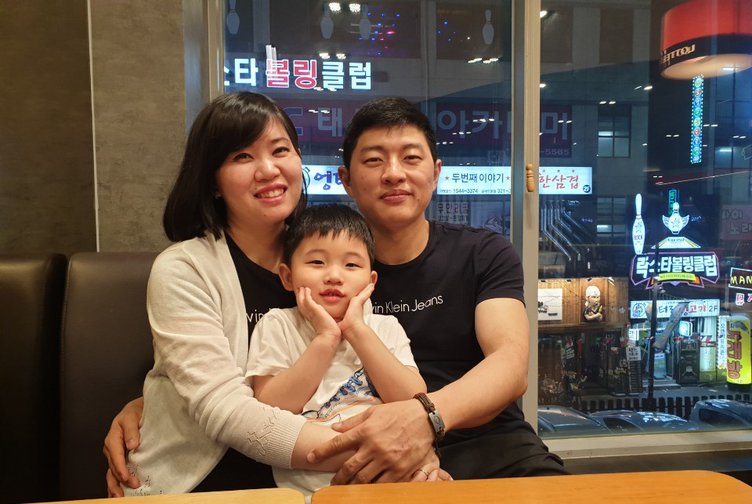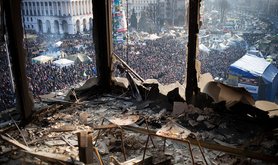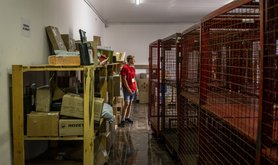
Central Asia’s Koreans in Korea: There and (Mostly) Back Again
Central Asia's Korean population is looking to South Korea for fast money, but not for long-term living.

Fearing Japanese espionage in the Soviet Far East, in 1937 Stalin deported some 170,000 Koreans from these border areas to uninhabited regions in northern Uzbekistan and southern Kazakhstan. These Koreans had originally settled in Primorye after fleeing famine on the Korea peninsula in the 1860s. Today, the number of Koreans living outside the peninsula counts up to seven million people, and more than 300,000 live in Central Asia as a result of this massive deportation.
On arriving to Central Asia after an exhausting train journey on the Far Eastern Railway, some Koreans were hosted by the local population. Many others had to build earth dugouts to survive in the steppes. As Soviet officials could not memorise Korean first names, new arrivals were given Russian ones, but were allowed to keep their family names. They integrated into the Soviet “melting pot” and adopted Russian, the Union’s lingua franca, as their language. The Korean population participated in the Soviet agricultural plan, cultivating rice, onion, garlic and other vegetables on their collective farms. According to historian Valery Khan, Korean-run farms distinguished themselves for high labour productivity.
Khan, an ethnic Korean living in Uzbekistan, writes that “Koreans could forget and suppress a sense of humiliation and resentment” over Stalin’s deportation by applying themselves to work on the land in the collective farms - their work ethic earned them the respect of the local population. Before Stalin’s death in 1953, the Korean population in Central Asia was not allowed to study at university or serve in the army. The Soviet leadership feared they could engage in espionage for the enemy or even switch sides.
Nowadays, many ethnic Koreans are part of Central Asia’s growing middle class: they run their own small businesses, such as restaurants and beauty salons, and enjoy a good standard of living. But in recent years, a rising number of Central Asian Koreans are travelling to their historic homeland to search for a better life for themselves and their family. They view Korea as a wealthy nation where they can earn much higher salaries than back home, part of which can be sent home to build houses, buy apartments, cars, and other commodities. They join the millions of Central Asian labour migrants mostly living in Russia and Kazakhstan, and whose remittances constitute a significant percentage of their countries’ GDP.
According to figures provided by the Korea National Statistics Office, 3,625 overseas Koreans arrived in the country from Central Asia in 2017, compared to only three people in 2008, a year after the long-term visas for overseas Koreans were launched. Between 2007 and 2017, 12,885 Koreans from Uzbekistan, Kazakhstan, and Kyrgyzstan have moved to Korea. Many of them do not have higher education and come to Korea to earn money fast and then return home, living in cities such as Incheon, Ansan and Gimhae, where many Koreans from Central Asia and Russia reside.
Should I stay or should I go?
Central Asian Koreans are open about their reasons to migrate and, in general, express the desire to return home after having accomplished their aims. Usually, these can be summarised as earning enough to buy an apartment and a car, and, if possible, to open a business back home. Migrating to Korea became easier with several immigration policy changes for citizens of post-Soviet countries initiated by the Korean government in the second half of the 2000s.
With little knowledge of Korean language and of the procedures to legalise their status as labour migrants once in Korea, Central Asian Koreans ended up mainly working in so-called “3D” factories, where work is “dirty, dangerous, and difficult”. They construct details for refrigerators and air conditioning units, build Korean cars and ships, oil pipelines for export, do electroplating, make plastic materials and other industrial works, contributing to the country’s steady economic growth.
"You cannot compare my salary here and what I was earning in Uzbekistan. How can you compare 2,000 USD with 100 USD?"
Dmitry Ten, 32, came to South Korea from Uzbekistan in 2014 in order to earn money for his wedding. “I came to Korea to earn money fast,” he told openDemocracy. After five months, he returned to Tashkent and got married but, unlike many of his compatriots, he decided to move to Korea for good with his wife, Irina. “You cannot compare my salary here and what I was earning in Uzbekistan. How can you compare 2,000 USD with 100 USD? So we decided we did not want to struggle in Uzbekistan,” the couple said. “Thanks to Korea, our countrymen can accomplish their goals, by saving money and buying apartments or cars in Uzbekistan,” adds Irina. Today, Dmitry works at a factory that produces details for air conditioning units in cars, while Irina works at a Korean make-up company.
Irina learnt Korean and taught it to Dmitry, and their four-year-old son is bilingual. “We do not want to go back to Uzbekistan because of the salaries and the lack of opportunities for kids,” she confides. Both spouses are enrolled in a long-distance education at a theological seminary, which, for Dmitry, is an opportunity for further upward mobility. “I want to develop myself spiritually, and do not want to work at the factory for a long time. It is hard to do heavy physical work every day for years,” he says. Every Sunday, Dmitry acts as a preacher at the Russian-speaking church in Gimhae, which also doubles as a place for Central Asian Koreans to gather, discuss and catch up.
Yury Khan, 30, from Shu in Kazakhstan, came to Korea in 2016 to earn money to buy and apartment and launch his own business back home. After finishing high school, Yury worked as a barman in Nur-Sultan, the Kazakh capital. “In Korea, there is an opportunity to earn good money,” he tells me. Yury works in a factory that produces raw materials for plastic commodities. And while the work is hard, Yury says, the salary and respect of the factory management encourages him to plow on. His wife and son should soon join him in Gimhae, though he plans to return to Kazakhstan in five years. He wants to open a business selling used Korean cars and spare parts.

An ethnic Korean from Russia, Efim Park, 58, migrated to Korea in 2017 to make money towards opening a restaurant and hotel in the Russian city of Volkhov, where he used to work as an electrician, though he’s an engineer by profession. Back in Volkhov, his and his wife’s salaries were not enough to save money, so he left for Korea. “I want to leave my business to my son so that he won’t struggle to live in Russia.” He speaks with pride of his great grandfather, who was born in Korea. “He was a shipowner and entered the territorial waters of the Russian Empire to trade fish with Russians.” During the 1937 deportation, Efim’s father was moved to the village of Ushtobe in southern Kazakhstan. “The train left my father and other Koreans at the railway station in the empty Kazakh steppes and went away,” he recounts. After the dissolution of the USSR, Efim and his family moved to Russia.
Although it is difficult to trace Central Asian Koreans’ payments specifically, remittances from South Korea to Central Asian states have been steadily growing in recent years. Kazakhstan’s National Bank notes that Kazakh citizens working in South Korea sent home 104.8 million USD in 2018 in comparison to 1.7 million USD in 2012. The same trend has been observed in Uzbekistan, where the largest number of Central Asia’s Koreans reside. In 2018, Uzbek migrant workers in Korea sent home 108.3 million USD, in comparison to 49 million in 2016.
Galina Khegay, a policy analyst and an ethnic Korean from Uzbekistan, explains that the Korean government did not pursue a policy of “repatriation” of Soviet Koreans immediately after the collapse of the USSR.
“While Germany, Russia, and Poland repatriated their ethnic population from Central Asia after 1991,” Khegay says, “South Korea didn’t, as it mainly aimed to return Koreans from Western countries, whose high skills and Western education could help boost the Korean economy after the 1997 Asian Financial Crisis.” According to Khegay, one of the reasons the Korean government was slow to “return” Soviet Koreans was the fear of a massive flow of migrants. Moreover, capitalist South Korea was cautious to repatriate immigrants from post-Communist countries.
In 2007, the Korean government did enact a law on immigration for overseas Koreans, issuing work visas for Koreans from the former USSR. Since then, many working-class Koreans have moved to Korea. Yet for now, the majority of the Central Asian Koreans are staying put in Central Asia. Inna Khan, 36, who studied international relations at the Kyrgyz Russian Slavic University, today owns a beauty salon in Almaty, Kazakhstan, and is not thinking about moving to her historical homeland. “I do not see any reason for me to leave for South Korea. I am used to living here, I feel comfortable, I like my job, and the mentality of our people is closer to me.” For “our people”, obviously, she means Central Asians.
“I wouldn’t feel like a full-fledged citizen in Korea. I don’t know the Korean language and culture”. Echoing Khegay, Inna concludes: “If I go to Korea, then only as a tourist.”
Read more
Get our weekly email





Comments
We encourage anyone to comment, please consult the oD commenting guidelines if you have any questions.